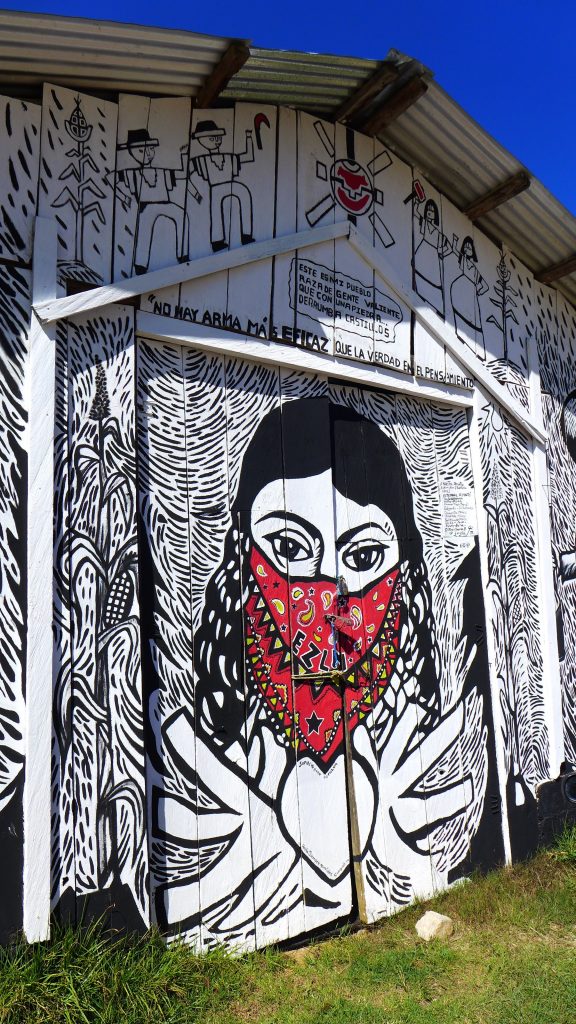(THIS ARTICLE IS MACHINE TRANSLATED by Google from Norwegian)
The fight for the rights of indigenous peoples continues in Mexico. Self-organized rebel communities coexist with Coca-Cola and religion in a surrealistic mix of anarchism and imperialism.
Today, San Cristóbal in the state of Chiapas is a popular tourist town. If we go back 25 years in time, until January 1, 1994 – the same day the NAFTA agreement officially came into force – the Zapatist guerrilla EZLN rode into San Cristóbal, equipped with its distinctive wooden rifles. They entered the town hall, threw the computers out of the windows and declared war on the Mexican government.
Fight for the rights of indigenous peoples
I find little here that testifies to the struggles that took place in the 90 years, but the conflict is still ongoing. Most recently in 2014, a teacher was killed when paramilitary attacked Zapatist collective La Realidad, an event that caused the famous subcomandante Marcos to change his name and reject all personal worship.
Coca-Cola's new plant has better access to water than the civilian population.
Facing New Time, the Zapatistas emphasize that the struggle for the rights of indigenous peoples has been going on for 500 years, ever since the Spaniards conquered Latin America. They demand dignity for the people who actually lived here long before the Europeans arrived.

When I go to the market to shop, I am surrounded by foreign words, a language that does not resemble anything I know. It is almost uncomfortable to have to resort to the imperialist Spanish language to communicate. Yet not everyone in Mexico speaks Spanish, even though the minorities, like the Kurds in Turkey, have to learn the "national" language at school.
However, the indigenous people's situation in Chiapas has changed drastically since the EZLN took action. Before 1994, they were subject to a curfew in San Cristóbal, and the women were almost wild. Now it is their culture that dominates the cityscape.
Capitalism also lives here
On a visit to Oventic, one of the Zapatist headquarters, I am lucky and will be present during an audience at "el buen gobierno" – the good government, if managers are replaced every 14 days. Where they sit in Finnish caps in a row and behind the desk, I get associations with ETA, but the tone is friendly. They take note of who we are (profession, nationality) before allowing us to navigate the area along with a few guide. On the way out of the Zapatthigh Castle, I notice the stack of cartons outside the local store – filled with empty Cola bottles. Capitalism also lives here.

One of the core points of the Zapatist uprising was the lack of proper infrastructure, such as access to water. This has gained increasing attention after Coca-Cola established a factory just outside San Cristóbal. The factory has better access to water than the civilian population – which ironically, Cola buys rather than water, since it is cheaper. In Uruguay, people often go with a thermos of hot water to the local matt-the drink under the arm; here's a two-gallon bottle of cola. According to the New York Times, the mortality rate for diabetic patients in Chiapas rose 30 percent between 2013 and 2016. This is the case when soda is more accessible than water.
Like the Kurds in Turkey, the minorities must learn the "national"
the language of the school.
After seeing examples of the Zapatistis burning churches in some areas of Chiapas – to show that they do not accept the religion that the Spanish conquerors forced upon them – I insisted that there be a church in Oventic. The astonishment increased as I witnessed families in the Mayula village of Chamula outside San Cristóbal sacrificing hens and roosters to chase away evil spirits. The ritual was usually concluded with the practitioners crossing and toasting in Coca-Cola. This strange blend of Christian faith and traditional rituals can probably be explained by the fact that the church was the only place indigenous people were allowed to perform their rituals. Perhaps the church does not mean more than the role we assign it.

A wolf in sheep's clothing
When Social Democrat Andrés Manuel López Obrador (AMLO) won the election in July 2018, many expected an improved dialogue between the Mexican government and the EZLN. But for the Zapatistas, the new president is a wolf in sheep's clothing. They fear that his popularity will only make it easier for the government to carry out its announced mega projects for development, mining and logging in Chiapas – without the indigenous people's consent. In particular, the so-called Maya train will cause tourism-related environmental pressures and threaten the way of life of the indigenous people.
San Cristóbal in the state of Chiapas a popular tourist town.
The Zapatists did, for the first time, stand with their own presidential candidate in last year's election – the herbalist María de Jesús Patricio Martínez of the Indigenous National Congress (CNI) – though without any ambition to win. The nomination, which breaks with the Zapatist tradition of not participating in national elections, was most symbolic, and an attempt to destabilize the political elite.
Equality has also always been one of the cornerstones of Zapatism, and the autonomous councils therefore consist of at least 50 percent women. After 20 years of self-organization, the Zapatist women on Women's Day last year shared their experiences of uniting women in the fight against capitalism and patriarchy. This year, the Congress was canceled, in protest of the new government's plans to expand tourism and commercial agriculture. The fight is ahead of them, they are asking women globally to fight on their respective home runs. La lucha sigue.






